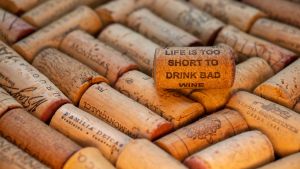How to to find out if you like aged wine
Do you like aged wine? It’s an acquired taste. Learn how to acquire it here.
The only way to learn about how wine ages is to drink a lot of wine at various stages of the aging process. There are four ways to get started with this new hobby. To learn more about aging wine, I consulted with Vanessa Conlin, Master of Wine and Michael Peltier, Senior Fine Wine Specialist at Millesima.
Option 1: Buy wine matured at the winery
Notice how I said “matured” not “aged?” Early in our conversation, Peltier was quick to point out this very important difference between wine that is maturing vs wine that is aging. Wine ages in the bottle, wine matures in other vessels (like oak barrels) before bottling.
Comparing some wines at different stages of maturation can provide you with an affordable primer on the basics of how wine changes as it gets exposed to small amounts of oxygen.
Conlin recommends exploring Rioja wines from Spain for this method of learning about “aged” wine. Unlike in the US, European countries with ancient wine-production histories have a lot of rules describing how grapes can be grown, how they can be made into wine, and they also assign quality labels to everything that earns them.
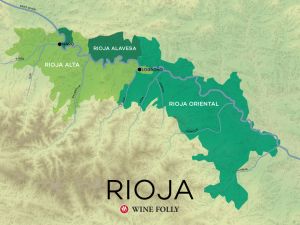 Map of Rioja Spain from Wine Folly
Map of Rioja Spain from Wine Folly
In the case of the Rioja region in Spain, there are specific requirements and names for wines of different maturity, in addition to specifications for growing and harvesting. The vast majority of red wine from Rioja (Rioja Tinto) is made from a grape called Tempranillo. The vast majority of white wine from Rioja (Rioja Blanco) is made from a grape called Viura.
- Crianza: “Crianzas are wines which are at least in their third year, having spent a minimum of one year in oak barrels. For white wines, the minimum barrel ageing period is 6 months.”
- Reserva: “These are meticulously selected wines with a minimum ageing between oak barrels and the bottle of three years, of which at least one has to be in barrels, followed and complemented by a minimum 6 months’ ageing in the bottle. For white wines, the minimum ageing period is 2 years, with at least 6 months in barrels.”
- Gran Reserva: “These are wines of great vintages that have been painstakingly aged for a total of sixty months with at least two years in oak barrels and two years in the bottle. For white wines, the minimum ageing period is 4 years, with at least 6 months in barrels.”
- Generic (or Joven): “This category guarantees the origin and vintage of wine. They are usually wines in their first or second year, which keep their primary freshness and fruit. This category may also include other wines that do not fit into the categories of Crianza, Reserva or Gran Reserva, if they have been subjected to an ageing process that is not certified by the Control Board.”
Rioja Bodegas to Try
As I’m not an expert on Rioja wine, it’s a bit difficult for me to recommend one specific bodega where you should explore the differences between these styles (bodegas are what we call wineries in Spain). Here is a list of bodegas with a good reputation, at a variety of price points. All bodegas listed here offer Crianza, Reserva, and Gran Reserva (sometimes more choices, too). My recommendation is to buy one of each from a single bodega and compare them. If you love the experience, try more. If you don’t… try Option 2.
Compañía Vinícola del Norte de España (CVNE)
- Crianza. Retails around $15. "Medium intensity of maroon colour. In nose, we can find aromas of wild fruits, liquorice together with vanillas, toffees and cocoa from the American oak barrels. Soft entrance in mouth with rounded tanins [sic] and a slightly acidic end which leads to a long and fruity aftertaste."
- Reserva. Retails around $25. "Medium intensity ruby in colour with a pink hint at the rim. The nose shows good aromatic intensity with aromas of fresh wild berries and liquorice which are typical of wines made from Tempranillo grapes. These are well integrated with the sweet spice aromas from the barrel ageing process. The palate is soft and marked by silky tannins and a long, fruity and youthful finish."
- Gran Reserva. Retails around $30. "Ruby red in colour, the wine shows a youthful hint at the rim. The nose reveals interesting and complex aromas of ripe fruits in perfect balance with spices, toffee, roasted coffee and balsamic notes. The palate is soft with silky tannins, good, fresh acidity and a long finish with a balsamic aftertaste."
Regions: Rioja Alta, Rioja, Spain
Grape Varieties: Tempranillo, Garnacha Tinta, Graciano, Mazuelo
Where to buy it (updated today)
Please note: if the wines aren’t an exact match, they’re there for a reason. Check those out,too!
La Rioja Alta, S.A.
- Crianza. Retails around $25. The La Rioja Alta Crianza bottling is called Viña Alberdi and its 40+ year old grapes are 100% Tempranillo from Mayorita, Rodezno, and Labastida. "Bright, deep ruby colour with intense dark cherry hues on the rim of the glass. It stands out for its intense ripe red fruit aromas like strawberries, raspberries and redcurrants complemented by pleasantly sweet spicy notes of vanilla, caramel, cinnamon, clove and nutmeg. The palate is round, with lively freshness at the start and sweet, supple tannins, leading to a long, fruity and balsamic finish, so characteristic of Viña Alberdi."
- Reserva. Retails around $40. The La Rioja Alta Reserva bottling is called Viña Ardanza and its 30-year old grapes are 80% Tempranillo from Cenicero and Fuenmayor, while its 20% Garnacha grapes are from Rioja Oriental. "Intense cherry red color, marking the garnet on the edge of the glass. Of great aromatic power, first of fruity character (cherry, currant, red plum) giving way then to balsamic and spicy notes (pepper, licorice, clove, vanilla, toasted caramel and nutmeg). Fresh and balanced in the mouth, with fine and silky tannins. Ample aftertaste that combines red fruits and spices with a fresh and long character."
- Gran Reserva. Retails $90-225. La Rioja Alta produces three Gran Reserva wines, all of which are highly sought after by fans and collectors. These wines are the Viña Arana Gran Reserva (current release is 2016), the Gran Reserva 904 "Selección Especial" (current release is 2015), and the Gran Reserva 890 (the current release is 2010).
Regions: Rioja Alta, Rioja, Spain
Grape Varieties: Tempranillo, Garnacha (Reserva and up), Mazuelo and Graciano (Gran Reserva only)
Where to buy it (updated today)
Please note: if the wines aren’t an exact match, they’re there for a reason. Check those out,too!
R. López De Heredia
- Crianza. Retails around $30. The LDH Crianza bottling is called Viña Cubillo (2015 is the current release) and its 40+ year old grapes are 65% Tempranillo, 25% Garnacha, plus Mazuelo and Graciano. "Clear, bright ruby. Fresh and slight aroma to licorice with consistent texture and persistent aroma. Smooth, fresh and persistent."
- Reserva. Retails around $60. LDH bottles several Reserva wines, but the most well known is the Viña Tondonia (current release is 2011). It is 75% Tempranillo, 15% Garnacha, and 10% Graciano and Mazuelo, which average 40 years old. "Light fresh texture with notes of vanilla and dried berry aromas. Rich, very dry, smooth, developed. Firm tannins and good balance."
- Gran Reserva. Retails $200+ (when you can find it). LDH’s Gran Reserva is highly sought after and hard to come by. I saw a 2001 at Wine.com as an exclusive for Stewardship members and Vivino has it listed by a merchant who doesn’t have it on their own website. It is 75% Tempranillo, 15% Garnacha, and 10% Graciano and Mazuelo, which average 40 years old. "Light fresh texture with notes of vanilla and dried berry aromas. Rich, very dry, smooth, developed. Firm tannins and balance."
Regions: Rioja, Spain
Grape Varieties: Tempranillo, Garnacha, Mazuelo, Graciano
Where to buy it (updated today)
Please note: if the wines aren’t an exact match, they’re there for a reason. Check those out,too!
Bodegas Muga S.L.
- Crianza. Retails around $20. The Crianza sold in the US is a different label than just "Bodegas Muga," it’s Muga El Anden de la Estacion. This is because Muga also makes a Reserva (it meets the requirement of this label) which is sold in Spain as Crianza (because Crianza is a big market in Spain).
- Reserva. Retails around $32. The 2020 is the current release and is a blend of Tempranillo, Garnacha, Mazuelo, and Graciano. "On the nose you discover an intense, complex wine. Aromas of wild fruits of the forest (blackberries and blueberries) come to the fore, with hints of spices. On the palate it is long, elegant and nicely balanced. Its sharp acidity is perfectly integrated and it has soft tannins. The finish is very long and full of fruit."
- Gran Reserva. Retails around $110. Has the label Prado Enea Gran Reserva and the current release is from 2016, also made from the full complement of grapes. "On the nose we find an elegant collection of forest fruit (blackberries) with spices like cloves and cinnamon. It has a silky-smooth attack with medium body and a very long, pleasant passage through the mouth. We find velvety tannins in perfect harmony with its fresh and well-integrated acidity. You can also find creamy and vanilla notes mingling with fresh fruit."
Regions: La Rioja Alta, Rioja, Spain
Grape Varieties: Tempranillo, Garnacha, Mazuelo, Graciano
Where to buy it (updated today)
Please note: if the wines aren’t an exact match, they’re there for a reason. Check those out,too!
Marqués de Cáceres
- Crianza. Retails around $20. The current release is the 2020. "Complex aromas of black fruits, combined with balsamic notes and delicate, fine, well-balanced oak. The nuances play a skilfully harmonious game. Gentle bouquet of fine leather with a touch of peppermint adding to the freshness in tasting. Well balanced wine that invites enjoyment with each glass. Full-bodied, frisky tannins, delicious in the mouth and pleasantly refreshing. An elegant, harmonious wine, with velvety tannins."
- Reserva. Retails around $25. The current release is the 2018. "An intense and complex nose, combining a multitude of pleasing sensations. Ripe black fruit flavours, milky , coconut and mocha notes are layered against an oak and balsamic background with harmonious structure. On the palate, the wine is flavourful and voluminous with mellow tannins and a subtle spicy finish revealing a hint of eucalyptus. A great wine which expresses luscious fruit, spicy touches revealing a strong identity of its origins."
- Gran Reserva. Retails around $150. The current release is the 2016. "Mature fruits (figs), spices, a backdrop of fine oak and finest leather add elegance and depth of complexity on the nose. Over time it maintains its rich expressiveness without losing intensity while preserving the enjoyable sensations of the wine. An excellent wine of great personality. Excellent on the palate, its silky tannin is complemented by a touch of luscious fruit. It reveals fullness as well as liveliness on the palate. The aftertaste is lengthy with a softly spicy finish."
Regions: La Rioja Alta and Rioja Alavesa, Rioja, Spain
Grape Varieties: Tempranillo and "other varieties"
Where to buy it (updated today)
Please note: if the wines aren’t an exact match, they’re there for a reason. Check those out,too!
Viñedos y Bodegas Sierra Cantabria
- Crianza. Retails around $15. The current release is the 2019 and is 100% Tempranillo. "Bright ruby colour. Fruity aromas of ripe red berries with lactic and toasted notes, as well as hints of black tea leaves. Fresh, pleasant, with fi ne tannins that develop tactile impressions. An easy-drinking wine."
- Reserva. Retails around $25. The current release is the 2016 and is 100% Tempranillo. "Bright ruby red. Intense and complex aromas (blackberries, spicy and toasted notes) that develop an elegant bouquet. Tasty, juicy and defined fruit. Smooth texture with good balance and a long finish."
- Gran Reserva. Retails around $50, but there are also some more expensive Gran Reservas from Sierra Cantabria. The current release is the 2012 and is 98% Tempranillo with 2% Graciano. "Cherry red with tones of maturity. Bright and luminous. Intense and complex on the nose with ripe red fruits, spices, toasted nuts and light hints of truffle. Fresh on the palate with a silky texture and fine, integrated tannins. Long and distinguished flavour."
Regions: Rioja, Spain
Grape Varieties: Tempranillo and Graciano
Where to buy it (updated today)
Please note: if the wines aren’t an exact match, they’re there for a reason. Check those out,too!
Option 2: Buy back-vintages from retailers
Back vintages are wines that are not the current release. A retailer who has older wine in inventory may have purchased more than it was able to sell through before the new release came out. It may keep these back vintages indefinitely until they sell out (a great opportunity for you to try older wine!), but I wouldn’t expect to see something more than 5 years old kicking around.
How to Get Started with Back Vintages
- Step 1: Pick a grape or a region that you’re familiar with and that you already enjoy.
- Step 2: Buy up to three vintages of the same wine from a single producer. Choose vintages one or two years apart depending on how granular you’re interested in getting.


Want to explore aged French wine?
In consultation with Millesima, I recommend building your own vertical of wine from Château Peyfaures (a vertical is three or more vintages of the same wine). This Bordeaux Superior is affordable for Bordeaux wines, classically-styled, and is organic. There are two verticals you can choose from this Château: the Grand Vin and the Dame de Coeur (slightly more expensive).
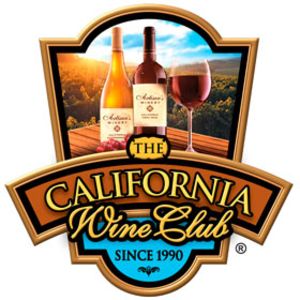

Want to explore aged California wine from small producers?
I recommend shopping at the wine stores of The California Wine Club and Gold Medal Wine Club (no membership required to shop their stores). Each carry an excellent selection of wineries and often have back vintages in limited stock for wines at a variety of price points.
Shop my trusted selection of back vintages by region and grape from online retailers.
Option 3: Try Aged Wine in Restaurants
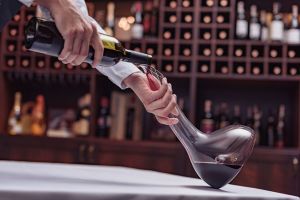
Another way to experience high-quality aged wine is to do so at fine dining establishments who specialize in filling and maintaining elaborate wine cellars. This is the most expensive way to enjoy aged wine, but you get a few bonuses with that extra money that you won’t get when you buy aged wine on your own.
It’s worth a side note here: great fine dining restaurants have sommeliers on staff. It used to be that this was what we expected sommeliers to do — serve great wine in great restaurants. These days sommeliers have all kinds of jobs which include sourcing wine for and even owning wine stores and wine clubs. Social media has made it so sommeliers are “the only real wine experts” that the public can trust. I still think critics are trustworthy, too. Regardless, I bring this up because while you may think of a somm as a wine expert, their expertise within the restaurant setting is what they were trained for.
A second side note: not all “wine program managers” or “wine waiters” at restaurants are sommeliers. Sommelier is an official job title granted by an educational system. It is not a generic term to refer to a wine expert. There are levels of sommeliers, too. Advanced Sommeliers and Master Sommeliers represent the most educated among them.
Back to buying aged wine in restaurants... If you’re at a restaurant with a serious wine program, they likely have an Advanced or Master Sommelier on staff. Odds are good that when you purchase an expensive aged wine in this setting, that’s who’s going to serve you. So, in addition to buying that perfectly cellared wine, you’re going to get a wine education (if you want it) about the wine you’ve purchased and its history.
You’re also going to get someone to professionally taste the wine to confirm it hasn’t gone bad — they won’t serve it to you if it isn’t in great condition, so this setting eliminates some of the risks associated with aged wine. The sommelier will treat the wine perfectly (properly decant, removing sediment and without damaging the delicate wine).
If this is a path you’re interested in pursuing, you can choose restaurants to patronize based on their wine cellar and sommelier. You can start your research with professionally-ranked wine programs like these.
Option 4: Buy your own wine and cellar it
This takes time (new releases you buy now won't be ready to drink for at least five years) and often a sizable investment in wine that you plan to age, not to mention proper long-term storage.
Aged Wine Lover's Tip: Buy a Coravin
At the point where you’ve plunked down some serious cash to support your wine drinking hobby, a few hundred dollars more for a Coravin isn’t really a budgetary stretch — it’s a hedge against time for your investment and a gift of wine education for yourself.
If you don’t already know, Coravin is a wine preservation system which allows you to “access” a bottle of wine to taste a small amount without spoiling the wine through oxidation. Learn more in our Useful Wine Guide about Coravin.
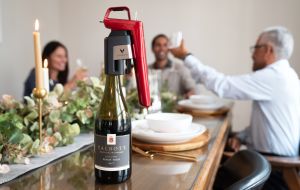
Along the way, it’s worth taking notes — specifically BLICCA notes. Assess the characteristics at the time of purchase, and reassess as you go. You’ll start to see the process of how the wine changes over time and become better at predicting which wines you taste are worth aging and for how long. The best part about doing this yourself is that you’ll learn what *you* like to drink — aged wine vs newer wine — not what a critic or even a winemaker thinks you should like.
How did we do this before the Coravin was invented? It was expensive and required massive amounts of storage. Wine lovers would buy up to a case of one specific wine, wait a few years, and then crack one open each year until it was perfect for that wine lover’s preferences. Now, you can do this with two bottles (or more) — keep one for Coravin taste-testing until you’re in love with it, then open the remaining bottle(s) for consumption with your favorite winos.
